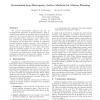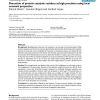207 search results - page 8 / 42 » Protein Sequencing Experiment Planning Using Analogy |
ECML
1991
Springer
13 years 11 months ago
1991
Springer
Robust reasoning requires learning from problem solving episodes. Past experience must be compiled to provide adaptation to new contingencies and intelligent modification of solut...
BMCBI
2006
13 years 7 months ago
2006
Background: Methods for predicting protein function directly from amino acid sequences are useful tools in the study of uncharacterised protein families and in comparative genomic...
CSB
2003
IEEE
14 years 29 days ago
2003
IEEE
Recognition of a protein’s fold provides valuable information about its function. While many sequence-based homology prediction methods exist, an important challenge remains: tw...
ICRA
2003
IEEE
14 years 28 days ago
2003
IEEE
We present deterministic sequences for use in sampling-based approaches to motion planning. They simultaneously combine the qualities found in many other sequences: i) the increme...
BMCBI
2008
13 years 7 months ago
2008
Background: Identifying the active site of an enzyme is a crucial step in functional studies. While protein sequences and structures can be experimentally characterized, determini...


